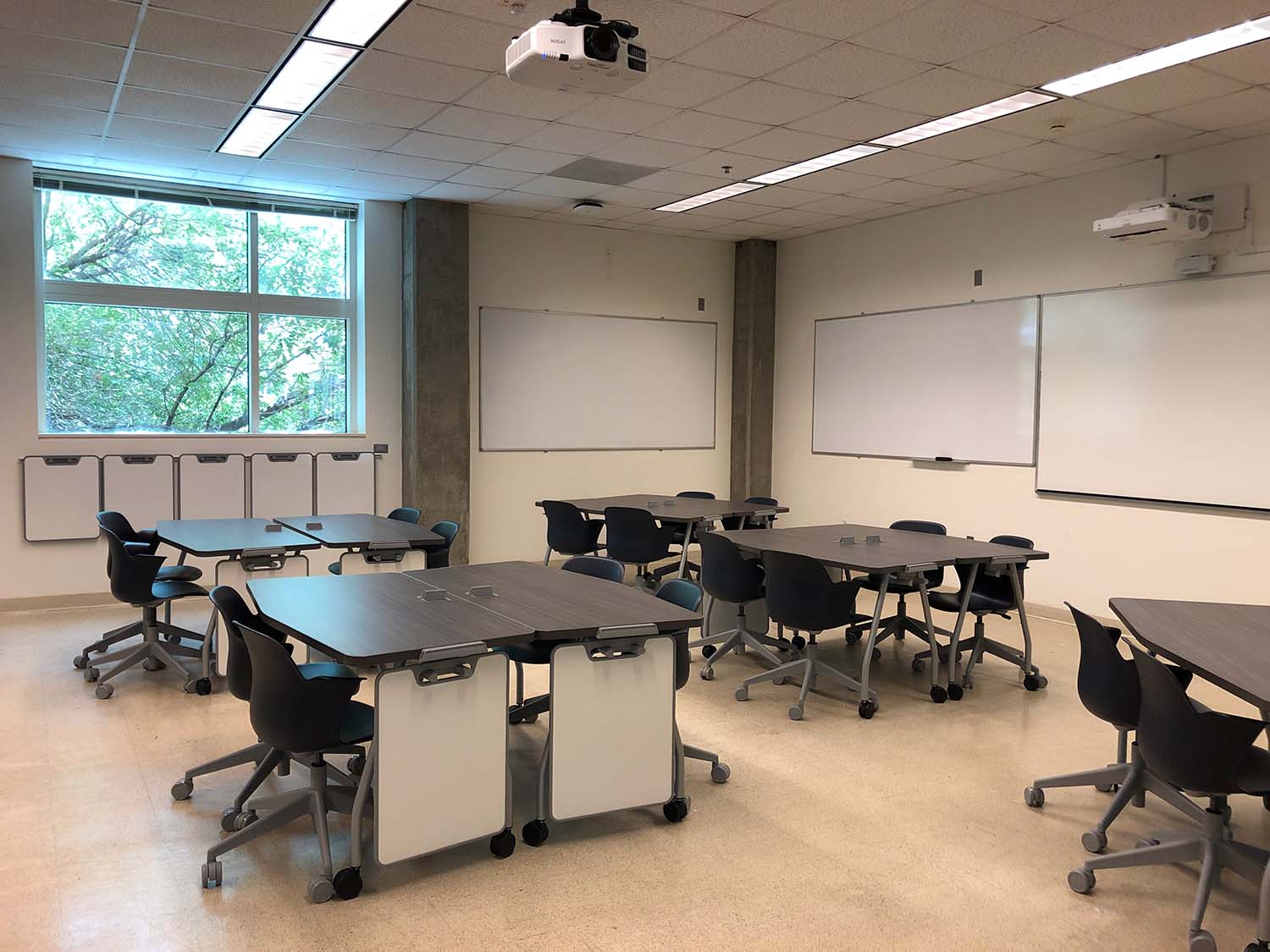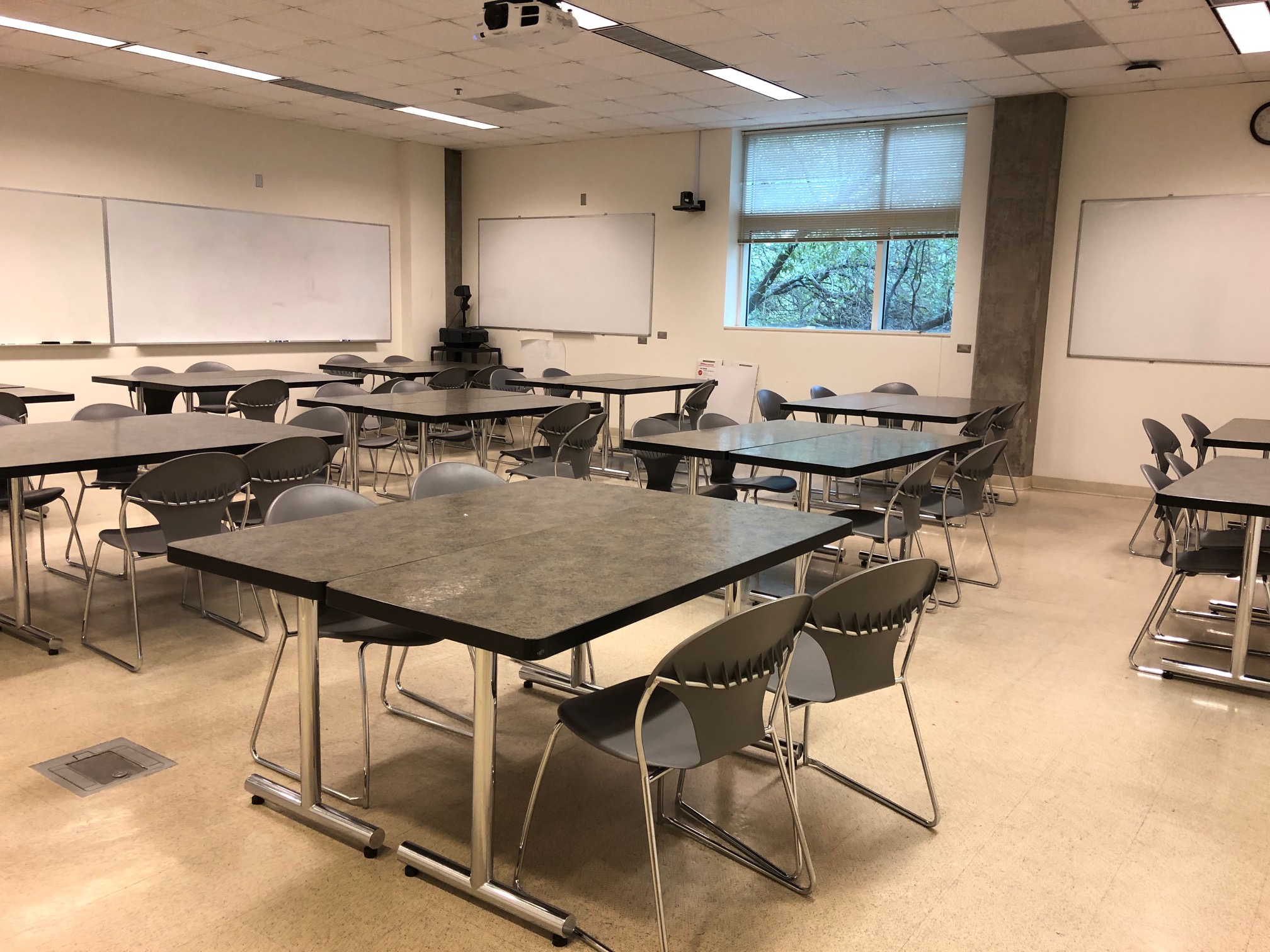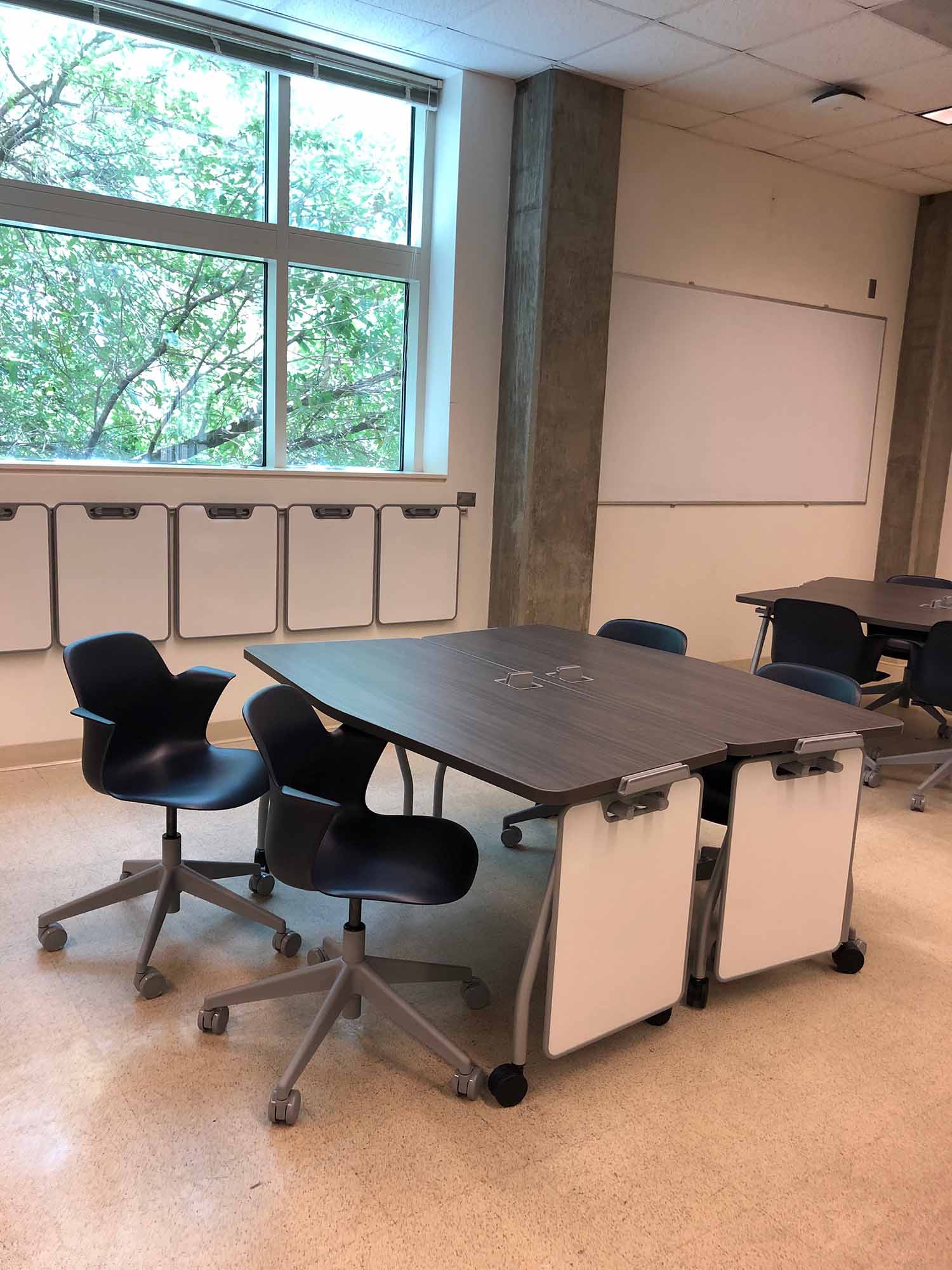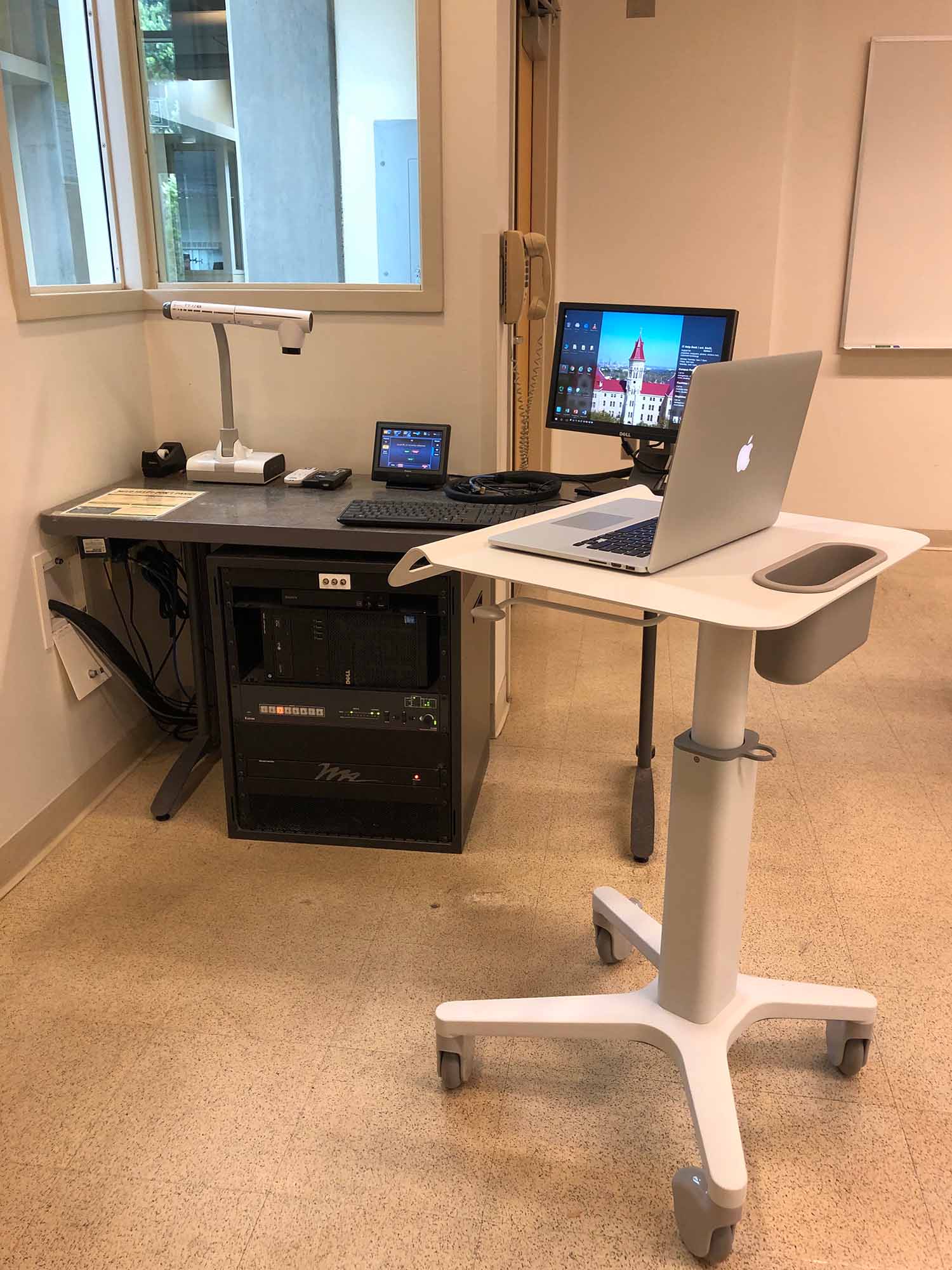Jul. 30, 2019
Laura Lucas is the Learning Spaces Manager in the Office of Information Technology. Here, she outlines what went in to the redesign of the JBWN 202 classroom space and what we and the School of Natural Sciences hope students get out of it.
Over the past several months, the School of Natural Sciences (NSCI) and the Office of Information Technology (OIT) partnered to redesign John Brooks Williams Science Center - North (JBWN) 202 as a technology-enabled, active learning classroom. The result of this joint effort is an exciting new learning space that promotes active, engaged student learning and enables faculty to put into practice a wide variety of pedagogical approaches.
What's New?



Active learning is a student-centered approach that promotes the creation of knowledge through discussion, problem-solving and other activities that require students to be active participants in their learning (Barkley, 2010). As more faculty begin adopting active-learning techniques, it’s become clear that classroom design, layout, available technology and other affordances all play a significant role in determining the types of activities that can be executed successfully in class.
Because of this relationship between pedagogy and physical space, learning spaces are rapidly emerging as an institutional priority across higher education (Brooks and McCormack 2019). Over the last several years, research on active learning classrooms (ALCs) has indicated a positive impact of ALCs on student success as measured by test scores, course success rates, retention rates, enthusiasm for learning and the development of 21st-century skills like collaboration, communication and critical thinking (Bonwell and Eison, 1991; Freeman et al., 2014; Lorenzo et al., 2006; Thaman et al., 2013).
St. Edward’s faculty recognize the impact of learning spaces on student learning and success and have identified them as a priority.
The Teaching, Learning and Technology Roundtable sponsored a survey of all faculty in Fall 2013 and again in Spring 2019 about their teaching practices, interests and priorities. The percentage of faculty identifying flexible classroom furniture as a high priority was high in 2013 at 68% and increased to 81% in 2019. Additionally, TLTR has included specific requests for learning space projects in its grant program call for proposals over the last two years; technologies funded through this initiative include interactive projection, wireless projection and mobile whiteboards.
Active learning techniques and practices have grown significantly across the School of Natural Sciences. In 2015, St. Edward’s was awarded a five-year grant of more than $1.6 million from the National Science Foundation (NSF) through the Improving Undergraduate STEM Education (IUSE) Program. A key component of this project is integrating more active, experiential and peer learning strategies into first-year STEM courses, which has increased the need for learning spaces that can accommodate these approaches.
Current Active Learning Spaces

The university currently has a handful of classrooms outfitted with flexible furniture and varying degrees of technology, and these experiments have given initial insight into the potential of active learning classrooms.
Moody 212 came online as an active learning classroom in Spring 2015, outfitted for maximum flexibility with tablet chairs on casters and small whiteboards.
Faculty feedback on this space has focused primarily on the ease of reconfiguration — the ability to switch from lecture to small groups, pairs and/or individual layouts without losing significant amounts of class time, exerting a lot of effort or creating a noisy disturbance for neighboring classrooms.
JBWN 206 was renovated in Fall 2016 thanks to a Steelcase Active Learning Center Grant and has been used primarily for chemistry courses. Analysis by NSCI has shown promising results in this space, including:
- a statistically significant drop in the DFW rate — that’s the number of students who received a grade of "D" or "F" or withdrew — from chemistry classes taught in JBWN 206 as compared to other classrooms
- increased scores on the National American Chemical Society first year conceptual exam
- improved student disposition
- student use of the room as an after-hours study space
Because the school’s pedagogical approaches depend heavily on the physical space in which classes are taught, NSCI partnered with OIT to expand the availability of active learning classrooms, as well as the institutional research on their impact.
St. Edward's Classrooms
Faculty will find a variety of classroom setups across campus. Check out this guide to see which is right for your teaching style.
What's Next?
Classes will be taught in the redesigned room starting with the Fall 2019 semester. The partnership between NSCI and OIT will continue as we assess how the redesign affects teaching practice, student engagement during class sessions, and student performance as measured by course grades.
The insights we gain from this research will inform future campus learning space projects.
References
- Barkley, E. F. (2010). Student engagement techniques: A handbook for college faculty. John Wiley and Sons.
- Bonwell, C. C., and Eison, J.A. (1991). Active learning: creating excitement in the classroom. ASHE-ERIC Higher Education Report No. 1, Washington, D.C.: The George Washington University, School of Education and Human Development.
- Brooks, D. C., and McCormack, M. (2019). Higher Education’s 2019 Trend Watch and Top 10 Strategic Technologies. Research report. Louisville, CO: ECAR, March 2019.
- Freeman, S., O'Connor, E., Parks, J., Cunningham, M., Hurley, D., Haak, D., Dirks, C., & Wenderoth, M. (2019). Prescribed Active Learning Increases Performance in Introductory Biology | CBE—Life Sciences Education.
- Lorenzo, M., Crouch, C., & Mazur, E. (2006). Reducing the gender gap in the physics classroom. American Journal Of Physics, 74(2), 118-122. doi: 10.1119/1.2162549
- Thaman, R., Dhillon, S., Saggar, S., Gupta, M., & Kaur, H. (2013). Promoting active learning in respiratory physiology - Positive student perception and improved outcomes. National Journal Of Physiology, Pharmacy And Pharmacology, 3(1), 27. doi: 10.5455/njppp.2013.3.27000